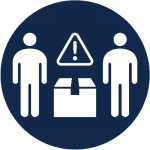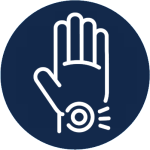Ergonomics
What is ergonomics?
Ergonomics can roughly be defined as the study of people in their working environment. More specifically, an ergonomist (pronounced like economist) designs or modifies the work to fit the worker, not the other way around. The goal is to eliminate discomfort and risk of injury due to work. In other words, the employee is our first priority in analyzing a workstation. Officially:
“Ergonomics (or human factors) is the scientific discipline concerned with the understanding of the interactions among human and other elements of a system, and the profession that applies theory, principles, data and methods to design in order to optimize human well-being and overall system performance.”
International Ergonomics Association Executive Council, August 2000
When evaluating a job, looking for three main characteristics known as ergonomic stressors: the force required to complete a task, any awkward or static working postures adopted in completing a task, and the repetitiveness of a task. Any of these factors, or any combination of these factors, may place someone at greater risk for discomfort.
- Providing information about ergonomics
- Giving on-campus training on ergonomics (as requested)
- Providing an online ergonomic self-evaluation tool. This tool will walk the individual through a self-evaluation and provide the user with recommendations to modify their workstation.
Departments are responsible for providing sufficient resources to implement ergonomic recommendations in a timely manner as well as ensuring that employees are properly trained.
EHS is responsible for evaluating and monitoring the ergonomic program including assessing the nature and extent of ergonomic hazards, recommending ways of minimizing or controlling these hazards, and supporting the University in consultation and direction regarding ergonomics. EHS is also responsible for ensuring that training on ergonomics is available to all employees.
- Repetition
- Is the number of motions or movements that are performed per cycle or per shift
- Force
- Is the muscles used to produce force in order to perform necessary activities such as lifting, grasping, pinching, pushing, etc.
- Extreme Postures
- Is when muscles are required to work at a level near or at their maximum capacity.
- Static Postures
- A special type of awkward posture which occurs when a body part is not moving, but is still doing work. Examples include sitting in a chair or holding an object.
- Contact Pressure
- Is the pressure from resting part of the body against a sharp edge or corner. Resting the wrists or forearms on an edge of a desk while typing is one example.
- Vibration
- Exposure to local vibration occurs when a specific part of the body comes in contact with a vibrating object, such as a power handtool. Exposure to whole-body vibration can occur while standing or sitting in vibrating environments or objects, such as when operating heavy-duty vehicles or large machinery.
- Cold Temperatures
- Reduce the natural elasticity of the body and reduce the sensation of touch (tactile feedback). In order to get the same amount of tactile feedback, and employee may exert more force than is necessary.
Employee exposure to these stressors can cause injury or some type of MSD.
- Numbness
- Tightness
- Tingling
- Swelling
- Pain
- Stiffness
- Redness
- Engineering Controls
- Are changes made to the workstations, tools, and/or machinery that alter the physical composition of area or process.
- Administrative Controls
- Are changes made to regulate exposure without making physical changes to the area or process, for example taking frequent breaks and job rotations. In general, engineering control are preferred as their goal is to reduce the presence of hazards.
- I need to buy some equipment for my workstation (a keyboard tray, mouse bridge, etc.). Do I need permission from EHS?
- No. Ergonomic equipment can be bought the same way as a stapler for your office. Talk to your department’s business manager for information on ordering office equipment.
- Do I need permission from EHS to change an aspect of my workstation?
- No. If you feel uncomfortable and moving your monitor makes you feel better, do it! Remember, if you are feeling pain that you believe is caused by or increased by your University work, contact the University Employee Occupational Health Clinic (UEOHC) as soon as possible.
- I feel that my workstation is improperly set up. What can I do?
- EHS offers an ergonomic self-evaluation that asks questions and generates a report specific to your office or laboratory workstation. The ergonomic self-evaluation takes most people 30-45 minutes of uninterrupted time to complete.
Remember that for now, the self-evaluation is for those working in an “office” or “laboratory” workstation environment.
- Does EHS pay for my new equipment (like my keyboard tray)?
- Your department pays for your new equipment.
- How do I know if my pain is work-related?
- This is determined based on the medical evaluation at the UEOHC. If you have not already been to the UEOHC for your work-related pain, please do this as soon as possible. Call 919-966-9119 to schedule an appointment.
- I think I might have carpal tunnel syndrome. What do I do?
- First, if you are experiencing pain that you feel is caused or increased by your University work, you need to make an appointment to visit the UEOHC as soon as possible.
- This piece of equipment has the label “ergonomic” on it. Does that mean it’s better than others?
- Many products today tout themselves as “ergonomic” because there is no real standard for this term yet. It doesn’t necessarily mean it is better.
Ergonomics Programs
General Information
- Ergoweb
- Duke University Ergonomics
- Yale University Ergonomics
- Information and Resources on Common Ergonomics Related Topics
- Arthritis
- Handout on Health: Rheumatoid Arthritis
- Back Pain Introduction
- Handout on Health: Back Pain
- General Elbow Injuries and Disorders
- Tutorial on Lateral Epicondylitis (tennis elbow)
- Shoulder Injuries
- Rotator Cuff Injuries
- General Wrist and Arm Injuries
- Carpal Tunnel Syndrome
- Fibromyalgia
- General muscle anatomy and how muscles and tendons are injured
- Chiropractors
- National Safety Council
- Bureau of Labor Statistics
- American Industrial Hygiene Association (AIHA)
- Board of Certification in Professional Ergonomics (BCPE)
- The International Society for the Study of the Lumbar Spine
Government Agencies
- US Department of Labor, OSHA
- OSHA’s Ergonomics website
- National Center for Health Statistics
- NC Dept. of Labor-OSHA, Ergonomics
- Government Accountability Office (GAO)
- NIOSH, National Institute of Occupational Safety & Health
- CDC, Center for Disease Control and Prevention
Office Ergonomics
Ergonomic Associations
- National Ergonomics Conference and Exposition
- The Ergonomics Society
- Human Factors and Ergonomics Society (HFES)
- Board of Certified Safety Professionals (BCSP)
- American Industrial Hygiene Association
Ergo Resources and Publications
- Ergoweb: What to look for in a keyboard tray
Miscellaneous
Ergonomics Topics
 Lifting and Material Handling
Lifting and Material Handling Musculoskeletal Disorders
Musculoskeletal Disorders Office Ergonomics
Office Ergonomics Laboratory Ergonomics
Laboratory Ergonomics Hospital Ergonomics
Hospital Ergonomics Home and Hobby Ergonomics
Home and Hobby Ergonomics
